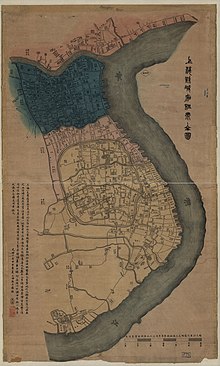American Concession (Shanghai)
| American Concession in Shanghai | |||||||||
|---|---|---|---|---|---|---|---|---|---|
| Foreign Enclave | |||||||||
| 1848–1863 | |||||||||
| History | |||||||||
• Established | 1848 | ||||||||
• Disestablished | 21 September 1863 | ||||||||
| |||||||||
This article needs additional citations for verification. (September 2024) |
The American Concession or Settlement was a foreign enclave (a "concession") within present-day Shanghai, which existed from around 1848 until its unification with the city's British area to form the Shanghai International Settlement in 1863.
The concession was located north of the Suzhou River and west of the Huangpu River, in what are today parts of Hongkou District and Jing'an District.


History
In 1845, the bishop of the American Episcopal Church, W. J. Boone, bought an area in Hongkew to create real estates in Shanghai to build a church. Later, Boone proposed to develop an American settlement, and in 1848, the Shanghai County approved the proposal. On 25 June 1863, American consul George Seward signed an agreement with the head of Shanghai County, Huang Fang (黃芳), to create the American Concession in Shanghai, which also confirmed the boundary of the area.[1] On 21 September 1863, the American area was merged with the British as the Shanghai International Settlement.
See also
- Shanghai International Settlement
- British Concession (Shanghai)
- Shanghai French Concession
- List of former foreign enclaves in China
References
- ^ "虹口区志>>第一编境域·建置>>第一章境域>>第一节境域变迁" (in Chinese). Shanghai Office for Local Chronicles. Retrieved 2019-07-28.


